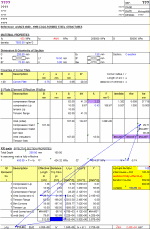Example Using Circular References to Force Iteration: Calculation Effective Section Modulus for Coldformed C-Section to AS4600

Description
Calculation of effective section modulus (Zex) using effective width methods of AS4600, for a coldformed c-section.
The workbook is dependent on:
schTechLib
It uses circular references to force iteration on the calculation of the section centroid. The web has a stress gradient and so the portion which is in compression and not effective is unknown. Has chunks are removed to determine effective width of plates, the section modulus of the c-section changes and so does the location of the neutral axis, and so the portion of the web in compression is different than initially assumed. The circular references force iteration until the difference between the initial assumption and the calculated value is insiginificant.
Calculation Reference
Cold Form Sections
Structural Analysis
Section Properties
The effective section modulus (Zex) for a cold-formed C-section can be calculated using the effective width method, as specified in the AS 4600 Australian Standard for Cold-Formed Steel Structures. The effective section modulus takes into account the reduced cross-sectional area of the section due to local buckling, which can occur in thin-walled cold-formed steel sections.
To calculate Zex for a cold-formed C-section, follow these steps:
- Determine the section properties:
- b: Width of the flange
- t: Thickness of the steel
- h: Height of the web
- r: Inner radius of the corner
- Determine the material properties:
- E: Young's modulus of the steel
- Fy: Yield strength of the steel
-
Calculate the half-wavelength (λ): λ = (π * E) / (0.95 * Fy)
-
Calculate the width-to-thickness ratio for the flange (bf/tf) and the web (h/tw), where tf and tw are the thicknesses of the flange and web, respectively.
-
Determine the effective width (be) for the flange and the web using the AS 4600 standard's provided equations or tables. These equations consider the width-to-thickness ratios, the material properties, and the type of loading and support conditions.
-
Calculate the effective cross-sectional area (Ae) by multiplying the effective width (be) of each element (flange and web) by its thickness and summing the results: Ae = (be_flange * tf) + (be_web * tw)
-
Calculate the effective moment of inertia (Ie) by summing the moment of inertia of each element (flange and web) about the centroid of the effective section: Ie = Ie_flange + Ie_web
-
Determine the distance from the centroid of the effective section to the extreme fiber in tension (ymax).
-
Calculate the effective section modulus (Zex): Zex = Ie / ymax
By following these steps, you can calculate the effective section modulus (Zex) for a cold-formed C-section using the effective width method according to the AS 4600 standard. This value can be used for structural design and analysis of cold-formed steel structures to ensure adequate strength and stability.
Calculation Preview
Full download access to any calculation is available to users with a paid or awarded subscription (XLC Pro).
Subscriptions are free to contributors to the site, alternatively they can be purchased.
Click here for information on subscriptions.

